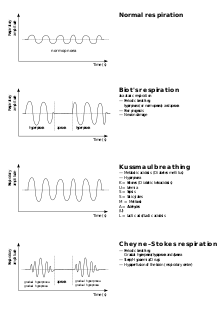Biot's respiration

Biot's respiration is an abnormal pattern of breathing characterized by groups of regular deep inspirations followed by regular or irregular periods of apnea.[1]
It is named for Camille Biot, who characterized it in 1876.[2][3]
Causes[]
Biot's respiration is caused by damage to the pons due to strokes or trauma or by pressure on the pons due to uncal or tentorial herniation.
It can be caused by opioid use.[4]
Diagnosis[]
Differential diagnosis[]
It is distinguished from ataxic respirations by having more regularity and similar-sized inspirations, whereas ataxic respirations are characterized by completely irregular breaths and pauses. As the breathing pattern deteriorates, it merges with ataxic respirations.
In common medical practice, Biot's respiration is often clinically equivalent to Cheyne-Stokes respiration, although the two definitions are separated in some academic settings.
it is different from Cheyne-Stokes breathing by how irregular it is.
References[]
- ^ "Biot respiration" at Dorland's Medical Dictionary
- ^ (in French) Biot MC. Contribution a l’étude du phénomène respiratoire de Cheyne-Stokes. Lyon Med. 1876;23:517-528, 561-567.
- ^ Wijdicks EF (May 2007). "Biot's breathing". J. Neurol. Neurosurg. Psychiatry. 78 (5): 512–3. doi:10.1136/jnnp.2006.104919. PMC 2117832. PMID 17435185.
- ^ Farney RJ, Walker JM, Boyle KM, Cloward TV, Shilling KC (August 2008). "Adaptive servoventilation (ASV) in patients with sleep disordered breathing associated with chronic opioid medications for non-malignant pain". J Clin Sleep Med. 4 (4): 311–9. PMC 2542501. PMID 18763421.
- Breathing abnormalities